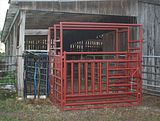texasjohn
Super Member
I'll give it a shot... my opinion based on observations.. your opinions may vary
There is only so much weight and size that an animal CAN express.
This expression occurs IF the animal is never stressed its entire life and ALWAYS has an optimum diet, etc. This is about the situation you are describing as related to the breeder who goes for the show ring and feeds grain lavishly. His animals will grow to their maximum ability in a minimum time.
To see this idea at work in another arena, check out your typical human family. Line 3 generations of males up. Grandpa will be the shortest. Paw will be taller than him. And, a 19+ yr old son will be the tallest of the group. Likely, same thing with the ladies. Think about it... in my case, Dad grew up literally walking behind a walking plow and his family ate popcorn one year because that was all there was to eat. Air conditioning and referigerators didn't exist for during his growth years and he had the resuilting stresses. He's the shortest. I am about 2 inches taller than him...born in WWII and I never recall being hungry, and I had vitimans growing up. Both my boys are 2 to 4 inches taller than I am... products of more enlightened dietary understanding, climate control and plenty of food and snacks at all times. I submit to you that the genetics are not ALL THAT different in the 3 human generations... but the DIET and environmental stressors are.
There is a high, but not perfect, correlation between an animal's ability to gain weight on grass versus grain. However, at every age point the grass fed animal will lag behind a grain fed animal.. on actual frame size and actual weight gain. The grass fed animal MAY be the most cost effective because it is likely that the cost of grass is less than the cost of grain, thus, the cost per lb gain can give the nod to raising animals on grass. However, time is a cost factor too.... so that can play into the equation.
Net.. your grass fed critters will NEVER look like their grain fed moms and dads... either in size or fat covering or whatever, they will be smaller... it's just not possible to achieve the optimum mix of protein, etc. from forage, as a practical matter, 24/7/365.
I love your mounted critter!
Hope your young bull works out for you... such a long time to find out... buy young bull, grow him out.. test his fertility, breed him..make sure he's interested in females, wait for a gestation period, see calves... grow them out to weaning... then on to yearlings, then breed heifers and find out their level of fertility, calving ease, etc... Takes about 5 years to prove a bull, I think.
There is only so much weight and size that an animal CAN express.
This expression occurs IF the animal is never stressed its entire life and ALWAYS has an optimum diet, etc. This is about the situation you are describing as related to the breeder who goes for the show ring and feeds grain lavishly. His animals will grow to their maximum ability in a minimum time.
To see this idea at work in another arena, check out your typical human family. Line 3 generations of males up. Grandpa will be the shortest. Paw will be taller than him. And, a 19+ yr old son will be the tallest of the group. Likely, same thing with the ladies. Think about it... in my case, Dad grew up literally walking behind a walking plow and his family ate popcorn one year because that was all there was to eat. Air conditioning and referigerators didn't exist for during his growth years and he had the resuilting stresses. He's the shortest. I am about 2 inches taller than him...born in WWII and I never recall being hungry, and I had vitimans growing up. Both my boys are 2 to 4 inches taller than I am... products of more enlightened dietary understanding, climate control and plenty of food and snacks at all times. I submit to you that the genetics are not ALL THAT different in the 3 human generations... but the DIET and environmental stressors are.
There is a high, but not perfect, correlation between an animal's ability to gain weight on grass versus grain. However, at every age point the grass fed animal will lag behind a grain fed animal.. on actual frame size and actual weight gain. The grass fed animal MAY be the most cost effective because it is likely that the cost of grass is less than the cost of grain, thus, the cost per lb gain can give the nod to raising animals on grass. However, time is a cost factor too.... so that can play into the equation.
Net.. your grass fed critters will NEVER look like their grain fed moms and dads... either in size or fat covering or whatever, they will be smaller... it's just not possible to achieve the optimum mix of protein, etc. from forage, as a practical matter, 24/7/365.
I love your mounted critter!
Hope your young bull works out for you... such a long time to find out... buy young bull, grow him out.. test his fertility, breed him..make sure he's interested in females, wait for a gestation period, see calves... grow them out to weaning... then on to yearlings, then breed heifers and find out their level of fertility, calving ease, etc... Takes about 5 years to prove a bull, I think.


